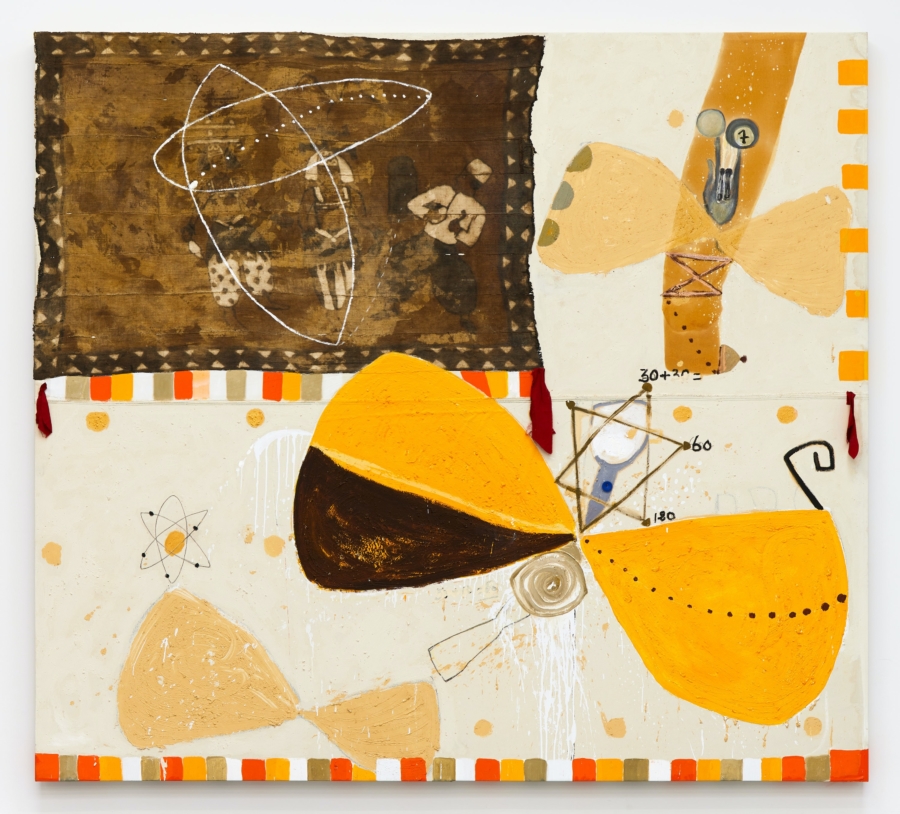May 21, 2022
Download as PDF
View on The Brooklyn Rail

Ouattara Watts, Sigui, 2002. Mixed media and collage on canvas, 107 5⁄8 × 119 7⁄8 inches. Courtesy the artist and Karma, New York.
Tathata is a Buddhist sentiment that translates roughly to “the suchness of things.” In practice, it’s trying to understand the essence of something before words can circumscribe it. For forty years, Ouattara Watts has similarly resisted being assimilated or codified. His exhibition Paintings, currently on view at Karma, reveals a dedicated and thoughtful practice of painting that can only be achieved through the experiences of a world traveler. Paintings tracks an irreducible and multivalent experience that is able to look both backwards and forwards through time; dealing with temporality in ways that attempt to reach beyond human scale. Through a deep reserve of work made over the last twenty years, Watts’s practice reflects various codes, various lineages, and various symbols, but ultimately resists any simplifying definitions. Instead, its trajectory follows an arcane “suchness”—compositional and transcendent lacuna that ultimately reminds us that painting predates language, flourishes where it fails, and penetrates deeper than words can.
Watts’s visual generosity owes itself to his experiences as a global citizen, and his work both engages with and passes through the conditions of multiple visual genealogies. There is a kinship with the COBRA lineage and its clobbering, flat shapes, its magnetic and unfussy automatism. There’s also an interest shared with Dieter Roth and Asger Jorn, and the desire to relate images to the flatbed surface of the canvas through ectoplasmic smears of paint. Then there’s the almost-familiar totemic shapes, similar to those that Pollock employed in the early ’40s or the spindly tendril marks of Gottlieb, demonstrating Watts’s interest in how simple but specific forms are able to communicate a timelessness, something epigenetic or pre-coded. Watts wields these tropes and indexes with an equalizing force, reworking a new palimpsest of painting that extends across continents.
However, there is an elevated interest and command of materiality, specifically textiles, in Watts’s practice that marks an important synthesis and adaptation of COBRA and the early AbEx artists. Some of Watts’s most exciting moments come from the stitching and assemblage of different fabrics and textiles, of pigment staining, and the way paint interacts with each surface and its individual complexities. Watts offers a deeply invested tachisme, applied to multiple conditions and surfaces, that intimately understands how pigment sinks and registers in each one.
Whatever symbols Watts utilizes appear more as an exploration of symbology writ large than an interest in their concrete meanings or contexts. There is the Eye of Horus, an important promise of both protection and restoration. Part lexicon, part ledger, Watts’s work also shows a reoccurring interest in numerology, in charts, in arrangements of numbers that avoid algebra, and instead count towards something we cannot know, imparting us with a cosmic vertigo, a God’s eye view of different cultural meanings. But then there’s the accordion effect of shuttling between macro and microscales, and Watts’s interest in situating the local experience within the cosmic. Motifs from the Ivory Coast, for example, appear fixed within his paratactic constellation of imagery. One of the most dynamic examples is found in Korhogo (2000), which takes its title from a city that was an important pre-colonial trade route and recently, a site of violent civil war, making it a poetic and metaphysical reflection of Watts’s own experiences with globalization. The repeating triangles that appear throughout the painting are an ornament in traditional Korhogo cloth, symbolizing tree leaves. Such cultural patterns and shapes dance with forms that seem carefully invented by Watts, like the furry hives and soft machines shown in Traveler in the Cosmos #3 (2019) and Citizen of the World II (2016), or the butterfly wings that turn into elephant feet in Sigui (2002).
Color throughout the exhibition keeps to mostly natural, primordial hues. Dominated by earthy beige, red ochre, deep obsidian, vivid sulphur, or cosmic blue, the paintings largely stay within the chromatic range of prima materia or subconscious dreams. The scale of the paintings makes them difficult to encounter all at once; we are the blind men in the parable of the elephant, groping towards an understanding of Watts’s artistic gestalt, piece by piece. Up close, you get caught up in individual communities of marks and fabrics, the border crossings of stains and textures, and lose the sense of the whole picture. It’s an experience of something like walking a landscape while simultaneously reading a map of the terrain you traverse.
Outtara Watts is engaged with a way of painting that thinks of the medium less in terms of its six hundred-year history since the Renaissance, and more as a means of communication that predates language itself. Whether we are dealing with a time before history or a cosmic dance, Outtara Watts was always there, significantly under-recognized but always making, undeniably a major figure when we think of painting in the last half-century.



